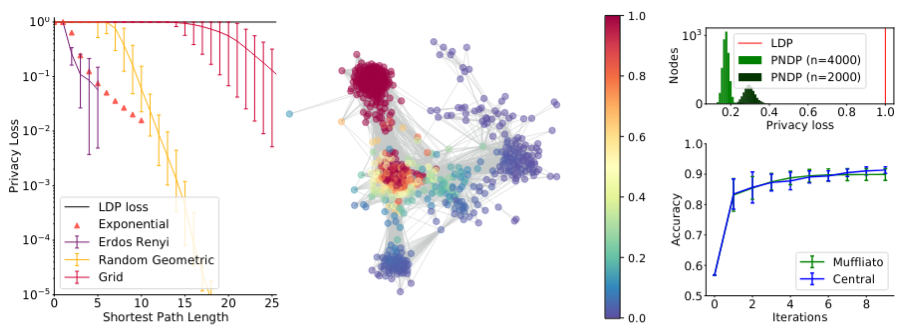This private repository contains the code for the paper Muffliato: Peer-to-Peer Privacy Amplification for Decentralized Optimization and Averaging.
The following packages are used: numpy matplotlib scikit-learn scipy networkx tqdm typer pathlib
The Facebook ego graph can be downloaded here: https://snap.stanford.edu/data/ego-Facebook.html and should be placed in a folder named 'facebook' in the project folder. The Housing dataset should be downloaded via the 'data' script, but can be manually retrieved there in case of problem: https://www.openml.org/d/823
Run figa.py
After downloading the Facebook Ego dataset as indicated before, run figb.py
Run gd.py to generate the data (takes several minutes, you can reduce the number of trials by adding '--n_trials 2 < INT< 10'). The files are saved in a folder 'result'
Run draw.py to generate the figure b on two seperate runs simulated with the gd.py files. Beware that you should specifiy which runs you want to use.
In command lines, to reproduce with the same parameters as in figure b
mkdir result
python --n_trials 10 --n_nodes 2000 --prefix "big" gd.py
python --n_trials 10 --n_nodes 4000 --prefix "huge" gd.py
python draw.py
Run fig2.py --graph-name hypercube/ER/geometric/grid to reproduce the figure 2. If no parameter is given, hypercube is used. You can also modify the number of nodes of those graphs.
Run fig3.pyto reproduce the Figure 3.
Run fig4.py to reproduce the Figure 4. Although no direct command is provided, you can easily modify the number of nodes, the positions of the node and the radius and starting node via variables n, pos, and u (line 24 to 30).
Run fig5.py to reproduce the Figure 5, after downloading the Facebook Ego graph as indicated before.
To generate a run of figure 6, run versatile.py by putting the seed in parameter and a prefix. This generates the two npy with the privacy loss and the mean square error at each step. By putting the list of the prefix generated, the plot can be done using fig6.py.
Core of the project
graphutils.pySeveral useful functions such as building the gossip matrix and computing the spectral gapmuffliato.pyMuffliato algorithm, non accelerated and accelerated versionERsampled.pyprivacy leakage for Erdös Renyi graph drawn randomly (theorem 4)
For synthetic experiments
figa.pyfor comparing several graphs as described in the main textfig2.pyfor visualizing the privacy loss of a fixed node on several graphsfig3.pyfor the privacy loss of the exponential graphfig4.pyfor the privacy loss as function of euclidean distance for random geometric graphs.fig6.pyfor visualizing the privacy with dropoutversatile.pyfor generating runs with dropout
For Fb experiments
figb.pygenerates the current Fb drawing, you can change the ego variable to run simulation on other graphsfig5.pyto generate the full gallery of Ego graphs.
For the Gradient Descent part
data.pyUsed for preprocessing the Housing dataset for the logistic regressiongd.pyMain file for the logistic regressionprivate.pylogistic regression utils and construction of Muffliato Logistic Regression algorithm
